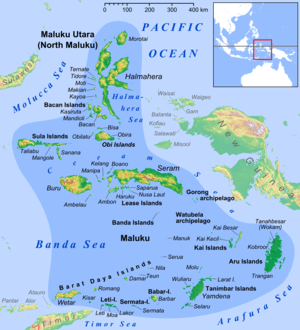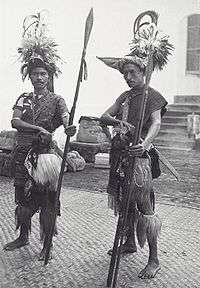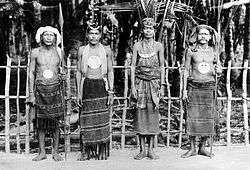Kisar
Kisar, also known as Yotowawa, is a small island in the Southwestern Moluccas in Indonesia, located to the northeast of Timor Island. It is included within the Southernmost Islands District (Kecamatan Pulau-Pulau Terselatan) within the Southwest Islands Regency of Maluku Province. The District also includes the larger (but less populated) Romang Island further north. It is one of the 92 officially listed outlying islands of Indonesia. The principal town is Wonreli, with 6,652 inhabitants at the 2010 Census.[2]
| Native name: Yotowawa | |
|---|---|
 Kisar in the south of Maluku Islands as a part of the Barat Daya Islands | |
| Geography | |
| Location | South East Asia |
| Coordinates | 8.06°S 127.18°E |
| Area | 81.83 km2 (31.59 sq mi)[1] |
| Administration | |
Indonesia | |
| Province | Maluku |
| Regency | Southwest Maluku Regency |
| District | Pulau-Pulau Terselatan |
| Largest settlement | Wonreli |
Geography, geology and ecology
Kisar is similar geographically and geologically to the nearby islands of Timor, Leti, and Moa. The interior of the island is hilly, with several small mountains lined roughly east–west. The highest of these, Gunung Taitulu, rises approximately 300 metres (980 ft) above sea level, and from the top, nearby Wetar and Timor are easily seen. The entire island is encircled by a series of rugged limestone cliffs that look like giant stairsteps rising from the coast. These uplifted terraces represent former coral reefs that have been thrust from the sea due to the active tectonics of the region.[3] Those terraces are also gently warped. An uplift rate of the island of approximately 0.5 mm/yr over the past several hundred thousand years has been calculated by obtaining ages of coral samples from the terraces.[4]
The rocks exposed in the interior of the island are primarily composed of low to medium-grade metamorphosed sedimentary rocks, with scattered amphibolites. The metasedimentary rocks are quartz-rich and the amphibolites represent mafic igneous intrusions. Age analyses of detrital minerals, petrology, and geochemistry all indicate that the island belongs geologically with the other islands of the Outer Banda Arc.[5] This series of islands formed when the northern edge of the Australian continent was upthrust in collision with southeast Asia. These islands are paralleled by the Inner Banda Arc, a series of active and extinct volcanic islands, including neighboring Wetar. The islands in the Banda Arc are arranged in a distinct horseshoe shape and represent a young, emerging mountain belt. Thus, Kisar represents one peak of a new mountain range rising from the sea.
The Timor Monitor (Varanus timorensis) is found in Kisar.
Language
The Kisar language (a trade language, also known as Meher or Yotowawa) and the unrelated Oirata language (closely related to Fataluku) are spoken on Kisar.[6][7]
History

The island was inhabited long before the colonial period. Cave paintings dating back 2,500 years have been found in Kisar after a wide-scale archaeological work.
In 1665 the Dutch VOC built a military base and named the island after the Kisar word for white sand. From the European outpost on Kisar a relatively large Indo Eurasian community developed named the 'Mestizo from Kisar' to this day their descendants live as Rajas and chiefs on Kisar. Surviving family names include: Joostenz, Wouthuysen, Caffin, Lerrick, Peelman, Lander, Ruff, Bellmin-Belder, Coenradi, van Delsen, Schilling and Bakker.
In 1795 Kisar was under British rule, in 1803 it was under Dutch/French rule and in 1810 again under English rule. In 1817 Kisar was returned to the Dutch until the outpost was abandoned in 1819. After that time Kisar upheld close ties with their Portuguese, Topasses and Timorese neighbours on Timor.

After WWII and Indonesia's independence the island was temporarily considered part of the segregated RMS, but ultimately became part of the unitary Indonesian state.
The current and 12th Raja (king) of Kisar, Johannes J. Bakker, succeeded his father Raja Hairmere Philipus Zacharias Bakker.[8] The first Raja Cornelis Bakker, who also ruled Wetar, Roma and Leti island via his brothers, was crowned ca. 1665.
Nowadays the Raja is respected as a traditional dignitary, but has no political power. The present Raja is well educated and for 5 years worked as a government official in nearby East-Timor, when part of Indonesia. There he met his wife Maria Antonette Ribeiru.[8]
Transport
Kisar has a small airport, near Purpura village on the north side of the island, with flights to Ambon, Moa (one of the Leti Islands) and Kupang. Passenger ships connect Kisar to Ambon, Kupang, and other nearby islands, and there are speed boats to Ambon and Moa.
Academic study
In 1928 the German Professor E.Rodenwaldt published his study "Die Mestizen auf Kisar", "Mikroskopische Beobachtungen an den Haaren der Kisaresen und Kisarbastarde".[9] His work is published in two German language volumes, one volume details measurements and photographs of the observed Mestizos. It contains a family tree showing the very complicated inter-marriages between the descendants of Mestizo families, as well as indicating skin, eye, and hair colour heredity. The study shows a unique natural experiment spanning over two centuries and is considered an essential academic work in the area of human heredity.[10][11]
References
- http://www.ppk-kp3k.kkp.go.id/direktoripulau/index.php?option=mod_pulau&id=preview&id_pulau=9091
- Biro Pusat Statistik, Jakarta, 2011.
- Major, Jonathan. "THE TECTONIC EVOLUTION AND REGIONAL SIGNIFICANCE OF KISAR ISLAND, INDONESIA". web.archive.org. Archived from the original on 2015-12-11. Retrieved 2020-06-07.
- Major, Jonathan; Harris, Ron; Chiang, Hong-Wei; Cox, Nicole; Shen, Chuan-Chou; Nelson, Stephen T.; Prasetyadi, Carolus; Rianto, Arif (2013). "Quaternary hinterland evolution of the active Banda Arc: Surface uplift and neotectonic deformation recorded by coral terraces at Kisar, Indonesia". Journal of Asian Earth Sciences. 73: 149–161. doi:10.1016/j.jseaes.2013.04.023.
- Major, Jonathan (2011). Evolution and Emergence of the Hinterland in the Active Banda Arc-Continent Collision: Insights From the Metamorphic Rocks and Coral Terraces of Kisar, Indonesia (thesis). Brigham Young University. Retrieved 2 March 2016.
- "Kisar". ethnologue.com. Retrieved 20 April 2018.
- "Oirata". ethnologue.com. Retrieved 20 April 2018.
- Pandanwangie (9 August 2005). "Indonesia Pusaka: Kisar - North of East Timor". riaulingga.blogspot.com. Retrieved 20 April 2018.
- Rodenwaldt, E. (20 April 2018). "Die Mestizen auf Kisar". Retrieved 20 April 2018 – via The Open Library.
- "Human hybrids in various parts of the world". www.mixedracestudies.org. Retrieved 20 April 2018.
- Family website. (in Dutch) Archived 2012-10-06 at the Wayback Machine
External links
| Wikimedia Commons has media related to Kisar (Indonesia). |